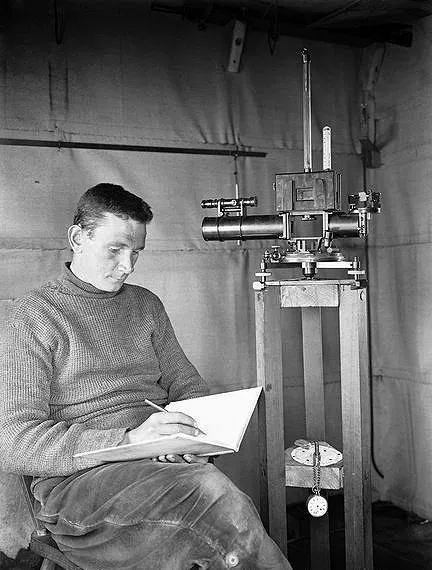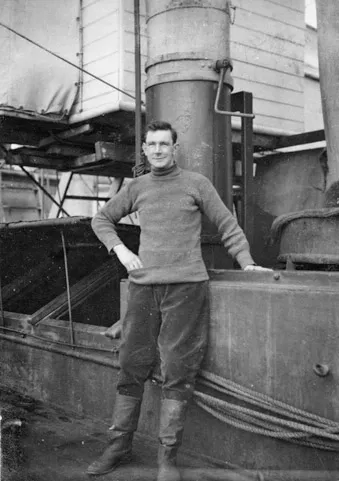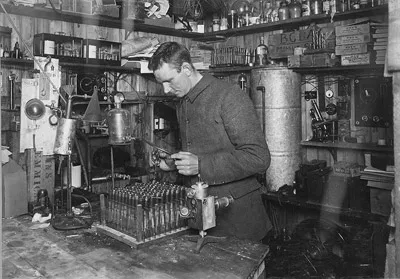George Clarke Simpson - Meteorologist
1878 - 1965 - Biographical
notes
Meteorologist Terra Nova 1910-13

George Simpson - Sunny
Jim
2nd September 1878 - 1st January 1965
Born in Derby, England, one of seven children, Simpson was the first person to lecture in meteorology at a British university when he was appointed in 1905 in Manchester, in 1906 he joined the Indian Meteorological Service at Simla before being appointed by Scott along with Charles Wright as two meteorologists to the Terra Nova expedition.
He was given the nickname "Sunny Jim" because of his resemblance to a character on cereal packets. Simpson spent most of his year in Antarctica at the hut at Cape Evans to maintain continuity of the meteorological records, he installed and maintained the most sophisticated array of recording apparatus that had been taken to Antarctica at that time producing reports on the weather and atmospheric physics that received wide acclaim.
Simpson, master of his craft, untiringly
attentive to the working of his numerous self-recording
instruments, observing all changes with scientific acumen,
doing the work of two observers at least and yet ever seeking
to correlate an expanded scope. So the current meteorological
and magnetic observations are taken as never before by Polar
expeditions.
Captain Scott
 He
accompanied Scott, Bowers and Evans on a sledging trip in October
1911, suffering a frostbitten face from walking into the wind.
As a meteorologist, he was required to take regular readings
and so stayed behind at the base at the time of Scott's
attempt on the South Pole. He returned from Antarctica on the
Terra Nova in early 1912 before the second winter.
He
accompanied Scott, Bowers and Evans on a sledging trip in October
1911, suffering a frostbitten face from walking into the wind.
As a meteorologist, he was required to take regular readings
and so stayed behind at the base at the time of Scott's
attempt on the South Pole. He returned from Antarctica on the
Terra Nova in early 1912 before the second winter.
While best known for his part in the Terra Nova expedition with Scott, Simpson's most important work and achievements came from his work following the expedition. On return from the Antarctic he went back to India. He was drafted into military service in 1914 at the start of WW1 as a meteorological advisor and served in Mesopotamia (now southern Iraq).
In 1920 he became Director of the Meteorological Office in London, where he became its longest serving Director until he retired in 1938. He was knighted in 1935. In the Second World War, he served in charge of the Kew Observatory. He was awarded honorary doctoral degrees by the universities of universities of Manchester, Sydney and Aberdeen.
"Simpson has been practising with balloons
during our absence. This morning he sent one up for trial. The
balloon is of silk and has a capacity of 1 cubic metre. It is
filled with hydrogen gas, which is made in a special generator.
The generation is a simple process. A vessel filled with water
has an inverted vessel within it; a pipe is led to the balloon
from the latter and a tube of india-rubber is attached which
contains calcium hydrate. By tipping the tube the amount
of calcium hydrate required can be poured into the generator.
As the gas is made it passes into the balloon or is collected
in the inner vessel, which acts as a bell jar if the stop cock
to the balloon is closed.
The arrangements for utilising
the balloon are very pretty.
An instrument weighing only
2 1/4 oz. and recording the temperature and pressure is attached
beneath a small flag and hung 10 to 15 ft. below the balloon
with balloon silk thread; this silk thread is of such fine quality
that 5 miles of it only weighs 4 ozs., whilst its breaking strain
is 1 1/4 lbs. The lower part of the instrument is again attached
to the silk thread, which is cunningly wound on coned bobbins
from which the balloon unwinds it without hitch or friction
as it ascends.
In order to spare the silk any jerk as
the balloon is released two pieces of string united with a slow
match carry the strain between the instrument and the balloon
until the slow match is consumed.
The balloon takes about
a quarter of an hour to inflate; the slow match is then lit,
and the balloon released; with a weight of 8 oz. and a lifting
power of 2 1/2 lbs. it rises rapidly. After it is lost to ordinary
vision it can be followed with glasses as mile after mile of
thread runs out. Theoretically, if strain is put on the silk
thread it should break between the instrument and the balloon,
leaving the former free to drop, when the thread can be followed
up and the instrument with its record recovered.
To-day
this was tried with a dummy instrument, but the thread broke
close to the bobbins. In the afternoon a double thread was tried,
and this acted successfully."
From Scott in "Scott's Last Expedition"
References to George Simpson by Cherry-Garrard in "The Worst Journey in the World"
-
Simpson was obviously a first-class scientist, devoted to his work, in which Wright gave him very great and unselfish help, while at the same time doing much of the ship's work.
-
The second cave, 13 feet long by 5 feet wide, hollowed out by Simpson and Wright, was for the magnetic instruments. The temperature of these caves was found to be fairly constant.
-
A sizzling on the fire and a smell of porridge and fried seal liver heralded breakfast, which was at 8 a.m. in theory and a good deal later in practice. A sleepy eye might see the meteorologist stumping out (Simpson always stumped) to change the records in his magnetic cave and visit his instruments on the Hill. Twenty minutes later he would be back, as often as not covered with drift and his wind helmet all iced up.
-
Simpson proved an excellent lecturer, and in meteorology and in the explanation of the many instruments with which his corner of the hut was full he possessed subjects which interested and concerned everybody.
-
Before she left for New Zealand the following members of our company joined the ship: Simpson, who had to return to his work in India;...
-
Simpson, in his meteorological report, has little doubt that the temperatures met by the Polar Party were abnormal. The records "clearly bring to light the possibility of great cold at an extremely early period in the year within a comparatively few miles of an open sea where the temperatures were over 40 degrees higher." "It is quite impossible to believe that normally there is a difference of nearly 40 degrees in March between McMurdo Sound and the South of the Barrier." The temperatures recorded by other sledge parties in March 1912 and those recorded at Cape Evans form additional evidence, in Simpson's opinion, that the temperatures experienced by Scott were not such as might be expected during normal autumn weather.
Simpson's explanation is based upon the observations made in McMurdo Sound by sending up balloons with self-recording instruments attached. These showed that very rapid radiation takes place from the snow surface in winter, which cools the air in the immediate neighbourhood: a cold layer of air is thus formed near the ground, which may be many degrees colder than the air above it. It becomes, as it were, colder than it ought to be. This, however, can only happen during an absence of wind: when a wind blows the cold layer is swept away, the air is mixed and the temperature rises.
The absence of wind from the south noted by Scott was, in Simpson's opinion, the cause of the low temperatures met by Scott: the temperature was reduced ten degrees below normal at Cape Evans, and perhaps twenty degrees where Scott was.
References to George Simpson by Scott in "Scott's Last Expedition"
-
Simpson and Wright are worthy of all admiration: they have been unceasingly active in getting things to the fore and I think will be ready for routine work much earlier than was anticipated. But, indeed, it is hard to specialise praise
where everyone is working so indefatigably for the cause. -
Simpson's Corner was the first visited. Here the eye travelled over numerous shelves laden with a profusion of self-recording instruments, electric batteries and switchboards, whilst the ear caught the ticking of many clocks, the gentle whir of a motor and occasionally the trembling note of an electric bell. But such sights and sounds conveyed only an impression of the delicate methodical means by which the daily and hourly variations of our weather conditions were being recorded - a mere glimpse of the intricate arrangements of a first-class meteorological station - the one and only station of that order which has been established in Polar regions. It took me days and even months to realise fully the aims of our meteorologist and the scientific accuracy with which he was achieving them. When I did so to an adequate extent I wrote some description of his work which will be found in the following pages of this volume. The first impression which I am here describing was more confused; I appreciated only that by going to 'Simpson's Corner' one could ascertain at a glance how hard the wind was blowing and had been blowing, how the barometer was varying, to what degree of cold the thermometer had descended; if one were still more inquisitive he could further inform himself as to the electrical tension of the atmosphere and other matters of like import. That such knowledge could be gleaned without a visit to the open air was an obvious advantage to those who were clothing themselves to face it, whilst the ability to study the variation of a storm without exposure savoured of no light victory of mind over matter.
-
In the evening Simpson gave us his first meteorological lecture - the subject, 'Coronas, Halos, Rainbows, and Auroras.' He has a remarkable power of exposition and taught me more of these phenomena in the hour than I had learnt by all previous interested inquiries concerning them.
-
Ponting gave us an interesting lecture on Burmah, illustrated with fine slides. His descriptive language is florid, but shows the artistic temperament. Bowers and Simpson were able to give personal reminiscences of this land of pagodas, and the discussion led to interesting statements on the religion, art, and education of its people, their philosophic idleness, &c. Our lectures are a real success.
-
Simpson has just given us a discourse, in the ordinary lecture series, on his instruments. Having already described these instruments, there is little to comment upon; he is excellently lucid in his explanations
-
Simpson is admirable as a worker, admirable as a scientist, and admirable as a lecturer.
-
To-morrow Bowers, Simpson, Petty Officer Evans, and I are off to the west. I want to have another look at the Ferrar Glacier, to measure the stakes put out by Wright last year, to bring my sledging impressions up to date (one loses details of technique very easily), and finally to see what we can do with our cameras.
-
It was 2 o'clock before we could find a decent site for a lunch camp under a pressure ridge. The fatigue of the prolonged march told on Simpson, whose whole face was frostbitten at one time - it is still much blistered.
Landmarks named after George Clarke Simpson
Feature Name:
Simpson Glacier and Simpson
Glacier Tongue
Type: summit
Latitude: 71°17'S
Longitude:
168°38'E
Description:
A glacier, 6 mi long, in the Admiralty Mountains. It flows northward
to the coast between Nelson Cliff and Mount Cherry-Garrard where
it forms the Simpson Glacier Tongue. The latter feature was
named by the British Antarctic Expedition (BrAE), 1910-13. The
glacier described was mapped by U.S. Geological Survey (USGS),
1960-63, and was so named because (with Fendley Glacier to the
east) it nourishes the Simpson Glacier Tongue.
Feature Name:
Simpson Peak
Type: summit
Latitude:
67°43'S
Longitude: 050°07'E
Description: Peak, 1,720 m, just E of Mount
George in the SW end of the Scott Mountains. Discovered in January
1930 by the British Australian and New Zealand Antarctic Research
Expedition (BANZARE) under D. Mawson. The position of the feature
was fixed by J.C. Armstrong of Australian National Antarctic
Research Expeditions (ANARE) in 1959.
Other Crew of the Terra Nova Expedition
Abbot,
George Percy - Petty Officer, R.N. - 1, 2, N
Atkinson, Edward
L. - R.N. - surgeon, parasitologist - 1, 2, D, P, S
Balson,
Albert - Leading seaman, R.N.- 1, 2
Bowers,
Henry Robertson - Lieutenant - 1, 2, D, C,
Po
Browning,
Frank Vernon - Petty Officer - 1, 2, N
Campbell,
Victor - Lieutenant, R.N. - 1, 2, N
Cheetham,
Alfred B. - Boatswain (Bosun), R.N.R.
Cherry-Garrard,
Apsley - Assistant zoologist - 1, 2, D, C, S
Crean,
Tom - petty officer, R.N. - 1, 2, D, P, S
Debenham, Frank
- Geologist - 1, 2, iW, iiW
Dickason,
Harry - Able Seaman - 1, 2, N
Evans, Edgar - petty
officer, R.N. - 1, iW, Po
Evans, Edward R.G.R. - Lieutenant, R.N. "Teddy Evans" -
second in command, and Captain of the Terra Nova - 1, D, P
Girev
(Geroff), Dmitriy - Dog driver - 1, 2, D, P, S
Gran,
Tryggve - ski expert - 1, 2, D, iiW, S
Lashly, William
- chief stoker, R.N. - 1, 2, P, S
Levick,
G. Murray - Surgeon, R.N. - 1, 2, N
Lillie, Dennis Gascoigne - Biologist
on the ship
McLeod, Thomas
F. - Able seaman - 1, 2
Meares, Cecil
H. - in charge of dogs - 1, D, P
Oates, Lawrence
- Capt. 6th Iniskilling Dragoons - 1, D,
Po
Ponting,
Herbert G. - Camera artist - 1
Priestley,
Raymond E. - Geologist - 1, 2, N
Omelchenko,
Anton - Groom - 1
Scott, Robert
Falcon - Commander, R.N. -
Expedition leader - 1, D, Po
Simpson,
George - Meteorologist - 1
Taylor,
T. Griffith - Geologist - 1, iW, iiW
Wilson,
Edward Adrian - chief of scientific staff and biologist - 1, D, C,
Po
Wright,
Charles Seymour - Physicist - 1, 2, iW, P, S
Key:
1 - first winter
2 - second winter
iW - first western party
iiW - second western party
N - northern
party
D - depot laying for south pole journey
P - south pole party
C - winter journey to Cape Crozier
S - search party for south Pole
party
Po - reached
South Pole
Biographical information
- I am concentrating on the Polar experiences of the men involved.
Any further information or pictures visitors may have will be gratefully received.
Please email
- Paul Ward, webmaster.
What are the chances that my ancestor was an unsung part of the Heroic Age
of Antarctic Exploration?


